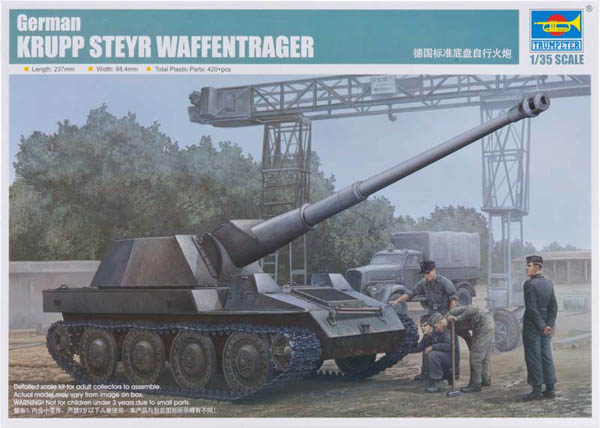
Trumpeter 1/35 Krupp WaffenTrager
By Don Barry
1/35 German Krupp-Steyr 88mm PaK 43/3 Waffen-
Trager (Weapons Carrier)
From Trumpeter Kit # TSM 1598 MSRP $59.95
420+ pieces
HISTORY
“The initial designs for Waffentrager based on the large and complicated Pz III/IV were built during 1943. Wa Pruf 4 (Ordnance Proving branch 4) decided that these were too heavy and too costly for the purposes of the Artillery. In February 1944 a new specification was issued for a Waffentrager to replace towed artillery weapons. Again, the weapon was to be dismountable but from a low rear platform without special equipment. The traverse was to be 360 degrees, fire height 1.8m and elevation -8 degrees to + 45 degrees. Krupp were given overall responsibility for the project, with Rheinmetall cooperating on gun aspects, and Ardelt and Steyr developing the chassis. The light-weight project was managed by a Herr Woelfort. Initially, it was intended to have a rear drive in keeping with current thinking, but the more conventional front was adopted as it allowed a lower gun platform. Steyr produced a vehicle with running gear based on the RSO (Raupenschlepper Ost=Tracked Tractor East) but the Ardelt design with Norman 38(t) wheels was accepted for production. The engine and transmission were placed to the right of the driver, and the driver’s compartment could be folded to give increased depression to the gun. Prototypes based on the 38(t) were built in late 1944. Production was to be on the basis of the 38(d) which featured a new transmission, the Tatra 103 220PS motor, and new idler/drive sprockets. A 38(d) was tested mounting the 8.8cm was tested successfully at Hillersleben on 27 April 1945.”
(from “Encyclopedia of German Tanks” by Chamberlain and Doyle.)
THE KIT
The kit is molded in butter-scotch-colored plastic, very cleanly, with no flash and minimal ejector marks. A small photo-etched fret is included featuring 88mm shell base plates, engine inlet screen, lifting lug bases, and the top plate on the sighting periscope. Separate track links are supplied, with 82 per side being recommended. The count is exactly right, and proper sag can be induced with the included jig. The links are easy to remove without leaving stubs to be cleaned up. A one-piece turned aluminum barrel is included, as well as a two-piece plastic one. The muzzle brake is two pieces, and is used with either barrel. Slide-molded shells are included, both live and empty. Care needs to be taken, as the entire suspension on each side is attached to the hull via one large pin. I painted it, and assembled, painted, and attached the tracks before proceeding to further steps, thus making the suspension less susceptible to damage. The gun assembly is a tight fit going into the turret, but the friction keeps it at the desired elevation. The turret must be pressed into an indentation on the hull floor to keep it from toppling over. I have no idea how the real gun was to be balanced, as it is extremely muzzle heavy. The molding includes very fine, delicate weld beads on the turret, gun sleeve, and hull. There are several items of interior and exterior stowage provided, which are not called out in the instructions; use where desired or save for later projects. The turret top/bottom and hull top/bottom are virtually a perfect fit. No fiddling is needed, just join and glue.
Different sub-assemblies were painted using different colors, or shades, to suggest their coming from varied sources. This was a very late war project, coping with a badly disrupted supply and transport system. An angular, hard edged paint scheme was used, as most fighting was taking place in built-up areas. It was accomplished using stretched and sliced Silly Putty as a masking medium, with German dark grey, field grey, dark yellow, and primer shades. National markings, kill rings, and instrument face decals are provided, but none were used. Final weathering was kept to a minimum, just some light rain streaking, and light accenting of edges and corners.
CONCLUSION
I very much enjoyed building and finishing this vehicle, though the likelihood of it ever having seen action is slim. Still, an interesting project, and the other Ardelt version is also available, as is the even more unlikely Waffentrager mounting the massive 128mm K 18/3 L 55 gun used on the Jadgtiger. Based on its ease of construction and menacing look, I find this kit well recommended, especially to fans of German weapons systems.
I offer my sincere thanks to Stevens International for supplying my review sample.
